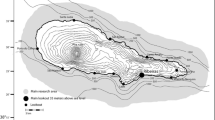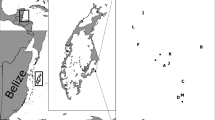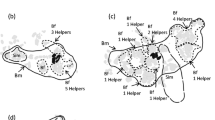Abstract
Observations of elasmobranchs in groups suggest sociality in sharks and rays. However we currently lack a strong understanding of social structure and the role kinship has in structuring group organization in cartilaginous fishes. The spotted eagle ray, Aetobatus narinari (Euphrasen, 1790) frequents the shallow waters near Sarasota, FL, often in pairs or groups suggesting a social component to their behavior. In the present study, eight eagle ray-specific microsatellite markers were used to investigate relatedness in A. narinari groups, and used to determine if kin structure contributed to group organization. Using regression-based and maximum-likelihood approaches, relatedness was quantified and compared within and among groups of juveniles, and adults in mixed sex and same sex groups. Results showed a lack of kin-structured sociality in A. narinari, suggesting factors apart from relatedness shape social interactions among spotted eagle rays in the near-shore waters of Sarasota, FL. Our results add to the limited amount of published literature on elasmobranch kinship, which are important for understanding implications of anthropogenic disturbance on genetic variability for coastal populations.



Similar content being viewed by others
References
Ajemian MJ, Powers SP, Murdoch TJT (2012) Estimating the potential impacts of large mesopredators on benthic resources: integrative assessment of spotted eagle ray foraging ecology in Bermuda. PloS one 7(7): e40227. doi:10.13871/journal.pone.0040227
Archie EA, Moss CJ, Alberts SC (2006) The ties that bind: genetic relatedness predicts the fission and fusion of social groups in wild African elephants. Proc R Soc B 273(1586):513–522
Baum JK, Myers RA, Kehler DG, Worm B, Harley SJ, Doherty PA (2003) Collapse and conservation of shark populations in the northwest Atlantic. Science 299:389–392
Bassos-Hull K, Wilkinson KA, Hull PT, Dougherty DA, Omori KL, Ailloud LE, Morris J, Heuter RE (2014) Life history and seasonal occurrence of the spotted eagle ray, Aetobatus narinari, in the eastern Gulf of Mexico. Environ Biol Fish. Submitted-in revision, same issue
Beecham JA, Farnsworth KD (1999) Animal group forces resulting from predator avoidance and competition minimization. J Theor Biol 198(4):533–548
Bigg MA, Olesiuk PF, Ellis GM, Ford JKB, Balcomb KC (1990) Social organization and genealogy of resident killer whales (Orcinus orca) in the coastal waters of British Columbia and Washington State. Report of the International Whaling Commission, Special 12:383–405
Blouin MS (2003) DNA-based methods for pedigree reconstruction and kinship analysis in natural populations. Trends Ecol Evol 18:503–511
Chang Z, Yang B, Vigilant L, Liu Z, Ren B, Yang J, Xiang Z, Garber P, Li M (2014) Evidence of male‐biased dispersal in the endangered Sichuan snub‐nosed monkey (Rhinopithexus roxellana). Am J Primatol 76(1):72–83
Coles RJ (1910) Observations of the habits and distribution of certain fishes taken on the coast of North Carolina. 50.7 (75.6)
Corcoran MJ, Gruber SH (1999) The use of photoidentification to study social organization of the spotted eagle ray, Aetobatus narinari (Euphrasen 1790). Bahamas J Sci 7(1):21–27
Cotterman CW (1941) Relatives and human genetic analysis. The Scientific Monthly 53:227–234
Croft DP, James R, Thomas P, Hathaway C, Mawdsley D, Laland KN, Krause J (2006) Social structure and co-operative interactions in a wild population of guppies (Poecilia reticulata). Behav Ecol Sociobiol 59:644–650
Croft DP, Hamilton PB, Darden SK, Jacoby DMP, James R, Bettaney EM, Tyler CR (2012) The role of relatedness in structuring the social network of a wild guppy population. Oecol. doi:10.1007/s00442-012-2379-8
Dobson FS, Viblanc VA, Arnaud CM, Muries JO (2011) Kin selection in Columbian ground squirrels: direct and indirect fitness benefits. Mol Ecol. doi:10.1111/j.1365-294X.2011.05218.x
Dugdale HL, Macdonald DW, Pope LC, Johnson PJ, Burke T (2008) Reproductive skew and relatedness in social groups of European badgers, Meles meles. Mol Ecol 17(7):1815–1827
Guttridge TL, Myrberg AA, Porcher IF, Sims DW, Krause J (2009a) The role of learning in shark behavior. Fish and Fish. doi:10.1111/j.1467-2979.2009.00339.x
Guttridge TL, Gruber SH, Gledhill KS, Croft DP, Sims DW, Krause J (2009b) Social preferences of juvenile lemon sharks, Negaprion brevirostris. Anim Behav 78:543–548
Hamilton WD (1964) The genetical evolution of social behaviour. J Theor Biol 7(1):1–16
Heithaus MR, Burkholder D, Hueter RE, Heithaus LI, Pratt HL Jr, Carrier JC (2007) Spatial and temporal variation in shark communities of the lower Florida Keys and evidence for historical population declines. J Fish Aquat Sci 64(10):1302–1313
Hoffman JI, Forcada J, Trathan PN, Amos W (2007) Female fur seals show active choice for males that are heterozygous and unrelated. Nature 445:912–914
Jacoby DM, Busawon DS, Sims DW (2010) Sex and social networking: the influence of male presence on social structure of female shark groups. Behav Ecol 21(4):808–818
Jacoby DMP, Croft DP, Sims DW (2011) Social behavior in sharks and rays: analysis, patterns and implications for conservation. Fish and Fish. doi:10.1111/j.1467-2979.2011.00436.x
Kalinowski ST, Wagner AP, Taper ML (2006) ML-Relate: a computer program for maximum likelihood estimation of relatedness and relationship. Mol Ecol Notes 6:576–579
Krause J, Ruxton GD (2002) Living in groups. Oxford University Press
Last P, Stevens J (1994) Sharks and Rays of Australia. CSIRO, East Melbourne
Larson S, Christiansen J, Griffing D, Ashe J, Lowry D, Andrews K (2011) Relatedness and polyandry of sixgill sharks, Hexanchus griseus, in an urban estuary. Cons Genet 12(3):679–690
Lima SL, Dill LM (1990) Behavioral decisions made under the risk of predation: a review and prospectus. Can J Zool 68:619–640
Lynch M, Ritland K (1999) Estimation of pairwise relatedness with molecular markers. Genetics 152(4):1753–1766
Mann J, Connor RC, Tyack PL, Whitehead H (2000) Cetacean Societies: Field Studies of Dolphins and Whales. University of Chicago Press; Chicago, IL
McEachran JD, De Carvalho MR (2002) Dasyatidae. In: K.E. Carpenter (editor), The living marine resources of the western Central Atlantic. Vol. 1: Introduction, molluscs, crustaceans, hagfishes, sharks, batoid fishes and chimaeras. FAO Species Identification Guide for Fisheries Purposes and American Society of Ichthyologists and Herpetologists Special Publication 5: 562–571. Rome: FAO
Milligan BG (2003) Maximum likelihood estimation of relatedness. Genetics 163:1153–1167
Mourier J, Vercelloni J, Planes S (2012) Evidence of social communities in a spatially structured network of a free-ranging shark species. Anim Behav 83(2):389–401
Myers RA, Worm B (2003) Rapid worldwide depletion of predatory fish communities. Nature 423:280–283
Newby JN (2013) An assessment of population genetic and social structure in the spotted eagle ray, Aetobatus narinari, off Sarasota, FL and the southeastern United States. MS thesis, College of Charleston, Charleston, SC
Queller DC, Goodnight KF (1989) Estimating relatedness using genetic markers. Evolution 43:258–275
Queller DC, Strassmann JE, Hughes CR (1993) Microsatellites and kinship. Trends Ecol Evol 8:285–288
R Development Core Team (2014) R: a language and environment for statistical computing. R Foundation for Statistical Computing, Vienna, Austria. ISBN 3-900051-07-0. http://www.R-project.org
Richard KR, Dillon MC, Whitehead H, Wright JM (1996) Patterns of kinship in groups of free-living sperm whales (Physeter macrocephalus) revealed by multiple molecular genetic analyses. P Natl Acad Sci 93(16):8792–8795
Sellas AB, Bassos-Hull K, Hueter RE, Feldheim KA (2011) Isolation and characterization of polymorphic microsatellite markers from the spotted eagle ray (Aetobatus narinari). Conserv Genet Resour. doi:10.1007/s12686-011-9415-6
Silk JB, Alberts SC, Altmann J (2006) Social relationships among adult female baboons (Papio cynocephalus) II. Variation in the quality and stability of social bonds. Behav Ecol Sociobiol 61(2):197–204
Silliman WR, Gruber SH (1999) Behavioral ecology of the spotted eagle ray, Aetobatus narinari (Euphrasen, 1790), in Bimini, Bahamas: an interim report. Bahamas J Sci B 7(1):13–20
Tagliafico A, Rago N, Rangel S, Mendoza J (2012) Exploitation and reproduction of the spotted eagle ray (Aetobatus narinari) in the Los Frailes Archipelago, Venezuela. Fish B-NOAA 110:307–316
Van Horn RC, Altmann J, Alberts SC (2008) Can’t get there from here: inferring kinship from pairwise genetic relatedness. Anim Behav 75(3):1173–1180
Viricel A, Strand AE, Rosel PE, Ridoux V, Garcia P (2008) Insights on common dolphin (Delphinusdelphis) social organization from genetic analysis of a mass-stranded pod. Behav Ecol Sociobiol 63(2):173–185
Wagner AP, Creel S, Kalinowki ST (2006) Estimating relatedness and relationship using microsatellite loci with null alleles. Heredity 97:336–345
Wang J (2011) COANCESTRY: a program for simulating, estimating and analysing relatedness and inbreeding coefficients. Mol Ecol Resour 11(1):141–145
Whitlock MC, McCauley DE (1990) Some population genetic consequences of colony formation and extinction: genetic correlations within founding groups. Evolution 1717–1724
Zeh JA, Zeh DW (2001) Reproductive mode and the genetic benefits of polyandry. Anim Behav 61(6):1051–1063
Acknowledgments
This project was supported by a College of Charleston Graduate Program in Marine Biology Genomics Fellowship and Slocum-Lunz Foundation Grant awarded to JN and by a College of Charleston Biology Department Faculty Research and Development Grant awarded to AMS. Approval by the IACUC committee was obtained before conducting research on the spotted eagle rays in this study. We thank the members of the Darden research group (SCDNR) for genotyping support. Allan Strand, Erik Sotka (Grice Marine Lab) and Anna Sellas (California Academy of Sciences) provided helpful discussions regarding experimental design, genetic sampling and statistical analysis. Tissue samples were obtained through the Spotted Eagle Ray Conservation Program at the Mote Marine Laboratory with support from the National Aquarium in Baltimore, Georgia Aquarium, Disney Worldwide Conservation Foundation, and Save Our Seas Foundation. We thank Peter Hull, Dean Dougherty, Greg Byrd, Krystan Wilkinson and the summer internship program at MML.
Author information
Authors and Affiliations
Corresponding author
Rights and permissions
About this article
Cite this article
Newby, J., Darden, T., Bassos-Hull, K. et al. Kin structure and social organization in the spotted eagle ray, Aetobatus narinari, off coastal Sarasota, FL. Environ Biol Fish 97, 1057–1065 (2014). https://doi.org/10.1007/s10641-014-0289-9
Received:
Accepted:
Published:
Issue Date:
DOI: https://doi.org/10.1007/s10641-014-0289-9




